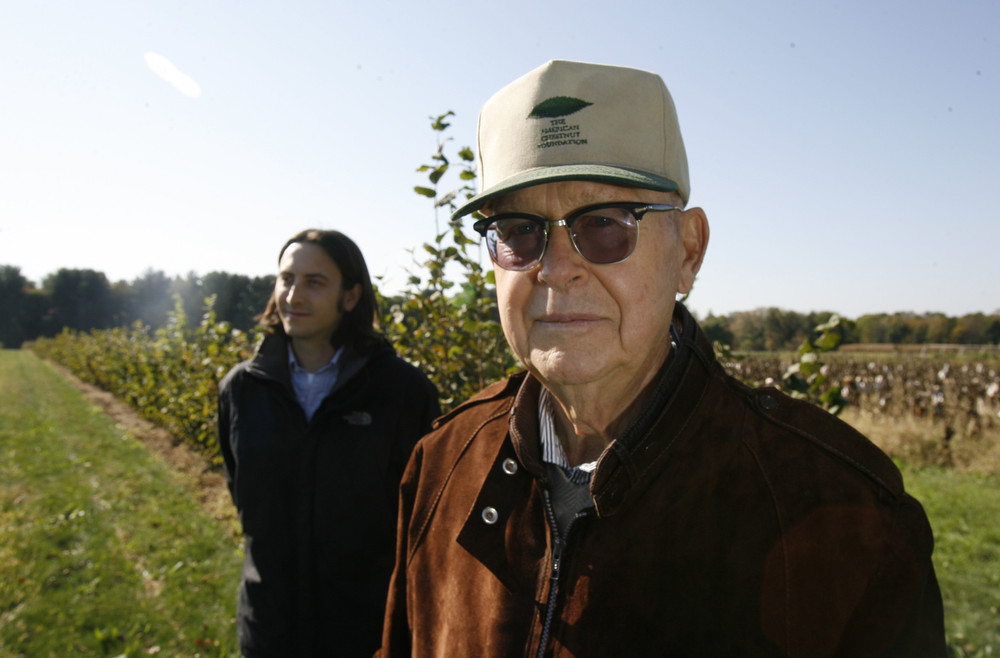Within its shell, Rutgers botanists see a world of possibility
The senior botanist had some advice for the budding scientist.
“Pick a species to study, preferably one that is ignored.”
He knew this would be the last student he would counsel in his long, acclaimed career.
“Find a problem with it, and work furiously on a solution as if you are racing against time.”
His hope was that theirs would be an enduring collaboration.
“And maybe, just maybe, you’ll make a contribution to science and the world.”
PHOTOS BY AMANDA BROWN/THE STAR-LEDGER
Caption: C. Reed Funk, right, a retired professor of plant science at Rutgers University, and his protégé Tom Molnar, an assistant professor at the university, visit one of the university’s research farms to check on the hazelnut trees Molnar is breeding and growing.
The legendary Rutgers University plant scientist C. Reed Funk, known to botany students as the “Turfmaster,” already had made himself and the department wealthy on royalties from his grass breed patents.
Now he had another big idea: breed a new, commercial-quality hazelnut tree for New Jersey and the northeastern U.S. And he wanted Tom Molnar, then a 19-year-old biology student working at Rutgers for the summer, to help him do it.
Funk told his young student that when he looked into the future, he envisioned ways the nutrient-rich hazelnut could help combat hunger in an overpopulated world, and saw that its oils could be converted into biofuels to provide an alternate source of energy.
Unlike annual crops, such as corn and wheat, hazelnuts are perennials, needing just one planting. They can grow almost anywhere – along ridges and rocky soil, marginal land farmers find too difficult or costly to cultivate. And their roots are deep, meaning that they are resistant to drought – an advantage in a world growing too warm.
If they could breed an American variety hazelnut with a hardy European type and produce a new line with the best characteristics of both, they could jump-start a local tree nut industry.
Molnar liked what he heard and trusted his teacher’1. s visionary instincts. What Funk failed to mention, however, is that new breeds of trees take more than a decade to produce.
It was 1997 and Funk, already in precarious health, was 69 years old. He knew then that if his dream had any chance, he needed the right young botanist to see it through.
That scientist would be Tom Molnar.
TENDING HIS CROP
On a crisp fall day last year, Molnar walks along a wide plain ringed by red-leafed trees on a Rutgers research farm in North Brunswick. Now an assistant professor in plant science at the university, he strolls through row upon row of green, waist-high bushes.
He’s not supposed to love his plants – as a breeder he must choose at some point to keep only a few and kill the rest, with a chainsaw. But his hands stroke their leaves and he bends their stalks as he examines them in a most unclinical way, closer to the way a mother might clasp her child’s arm on a stroll.
“Oh, this is going to be bad,” he says, as he spots ominous green bands on the branches of several saplings, a telltale sign of a deadly fungus. “They will be dead by spring.”
Funk and Molnar want to create a new hazelnut industry on the East Coast, particularly in New Jersey. They are growing one of the world’s largest collections of hazelnuts on Rutgers research farms in North Brunswick, Adelphia and Cream Ridge.
But breeding a new tree nut isn’t merely the act of crossing two varieties of plants and taking what comes. That’s been tried and hasn’t worked.
Funk and Molnar are taking crossbreeding to another level.
Funk is using the same techniques he learned from his decades as a turfgrass breeder. That means thousands of plants and thousands of crossings. And the characteristics that are desired go beyond disease resistance and good crops. They want to take resistance to frost into account. And, if the ornamental nursery industry is to take this on, it will want a tree with a certain look – perhaps one that turns red in the fall.
The scientists’ weapon is the ancient art of plant breeding, the purposeful manipulation of plant species, an activity that has been practiced since the beginning of human civilization.
It all rests in an artful eye, says Molnar. And Dr. Funk, which is what Molnar calls him, has it in spades.
“He can just look at a plant and tell whether it is worth keeping or not,” Molnar says. “Down the line, that’s what it’s all about.”
By observing Funk for so many years, Molnar has honed his own judgment, too.
“He’s a lot more intelligent and capable than I am,” Funk says.
A BREED APART
Classical plant breeding uses deliberate interbreeding or crossing of closely or distantly related individuals to produce new varieties. Plants are crossbred to introduce traits and genes from one variety into a new genetic background.
“We cross plants that we pick based on certain characteristics we feel are important in hopes of combining the best traits of either parent in the offspring,” Molnar said. “We plant out the nuts – the seeds – resulting from the cross and grow, for example, 100 seedlings, which are the progeny.”
From there, it takes about four years until the plants begin to produce nuts. From those, the scientists over time select the “best” of the group, the one most able to fight off disease and weather and produce ample, high-quality hazelnuts. The time span from planting a seed to judging the fruits of that labor is five to eight years.
Once they pick the winner, the scientists use it again, crossing it with a different plant that also exhibits important traits that may have been missing in an earlier generation.
The cycle is repeated several more times.
“It takes about seven years to know if you have something interesting, then another four or five years of work to develop it,” Funk said. “So you have to take the long view.”
Breeding never really stops. Improvements continue, but once plants are deemed suitable, they are made available to those who want to grow them.
FOLLOWING THE DREAM
Durning the first years of their collaboration, Funk and Molnar gathered samples of the American hazelnut tree, grew seedlings and studied their properties. They also sought seeds from foreign hazelnut trees. Other researchers had found that some trees carried a gene that protected the hazelnut from fungus.
But, Funk reasoned, an entire crop production effort could not rest on the protection of one gene. They were going to have to do better than that. They were going to need to find more plants that did not succumb to the blight. That meant they would have to search through many more hazelnut trees.
That’s when they started searching through trees in Central Asia with plant nutritionist and soil scientist, David Zaurov.
After leaving his native Uzbekistan and his post at Tashkent University, Zaurov joined the Rutgers staff in 1992.
It didn’t take long before the extroverted Zaurov offered to take Funk and Molnar to the fruit forests of Central Asia to collect specimens. The European hazelnut was introduced there in the mid-1800s and the nuts are sold at local markets.
The men also have traveled through Russia, Ukraine, Estonia, Latvia, Poland and Belarus looking for samples.
For the past five years, Molnar and Zaurov have scoured the deserts, scaled the mountains and driven treacherous winding roadways to get samples. When Funk learned of what lengths they were going to, he made a small suggestion: Just go to the local village markets, he said, and buy their hazelnuts. It’s tantamount to the same thing.
“He is a true genius,” Zaurov said. “He sees way ahead of everyone, and he finds simple answers to problems that seem complicated to everyone else.”
In genetic studies, the scientists have found that 13 seedlings out of 608 purposely inoculated with fungus showed no signs or symptoms of infection. Of those, seven originated from nuts purchased from roadside vendors near Simferopol, Crimea, Ukraine; five from nuts purchased at an outdoor market in the village of Holmskij near Krasnodar, Russia; and one came from nuts obtained from a breeding program of the Nikita Botanical Gardens in Yalta, Crimea, Ukraine.
The clusters, located nearly 400 kilometers apart, suggest the two sources of genetic resistance are unrelated and distinct, according to the researchers.
“No one’s been able to do this before,” Molnar said. “We’ve been able to get the most diverse collection of seeds by simply buying them from merchants who picked them off trees in their yards.”
‘ALWAYS LOOKING’
As a child growing up in Utah, Cyril Reed Funk found grade school boring. He was much happier doing chores on his family’s farm. He shaped up in college at Utah State, becoming a straight-A student. “I’m not sure what happened,” Funk said. “It just became a lot more interesting.”
After earning his doctorate at Rutgers in agronomy, he joined the faculty in 1962 with the assignment to improve turfgrass varieties.
Rutgers’ Cook College, on the suburban edge of New Brunswick, was surrounded by grass – lawns, sports fields, parks, institutional grounds and road berms. Most of it was defenseless against the diseases and pests of the mid-Atlantic and its extreme weather.
There was a great scientific opportunity for genetic improvement, and Funk spotted his chance.
He started by scouring the graveyards of New England where Europeans had planted native varieties of grass with seeds they had brought from the old country. The harsher climate of America, with its high humidity, tested those species. Funk plucked samples of the grasses that had survived nature’s test and thrived. He walked old golf courses along the eastern seaboard and plucked grass from places like the Sheep Meadow in Central Park.
His Kentucky bluegrass hybrid, U.S. Patent No. 4,223, a perennial ground cover designed to withstand the rigors of suburban life – regular mowing and heavy foot traffic – is listed by the University of Virginia as one of the “University Inventions that Changed the World,” along with genetic engineering, fluoride toothpaste and Gatorade.
“You get in the habit of always looking,” Funk said. “On vacation, you keep your eye out.”
Of the many species identified and improved by Funk’s search – including perennial ryegrass, creeping bentgrass, dryland bentgrass and strong creeping red fescue – some evidence of them can be found, according to Rutgers, on just about every lawn in the eastern United States, including the White House’s emerald expanse.
After stepping down in the mid-1990s, Funk started investigating an idea he had remembered reading in 1953 in a book called “Tree Crops: A Permanent Agriculture.” Its author, an emeritus professor at Columbia University named J. Russell Smith, had called upon America’s agricultural experts to revolutionize farming by abandoning efforts to improve annual crops, like corn and wheat, which deplete soil.
They needed to focus, Smith argued, on nut trees.
PASSING THE TORCH
When Funk first met Molnar he was immediately impressed with the young man’s intelligence and work ethic, he says.
Though Molnar is not overtly religious, “there is something that is so decent and good about him,” said the devout Mormon.
Like Funk, Molnar is a country boy at heart. Born in New Brunswick, he was raised in a small town called Jersey Shore, in central, rural Pennsylvania. His father is a mechanic; his mother works for an insurance company.
Molnar dreamed of being a wildlife biologist. He studied salamanders, frogs, toads and insects. “I was always dirty,” he said.
Once Molnar signed on to the hazelnut project, he transferred to Rutgers as an undergraduate student and never looked back.
While Funk talks almost nonstop, stringing together encyclopedic facts and figures on crop yields and carbon emissions – Molnar is by nature quiet and a listener.
“Dr. Funk would never say ‘Here is what I want you to do,'” Molnar says. “He always gave me free rein as a student, much more responsibility than my friends working with professors in other departments. Now, there is a lot of back and forth on ideas.”
Both men are environmentalists who want to save the world. But this is Molnar’s project now.
He is running his own field trials and supervising his own students and ground crew, much the way Funk used to do.
STAYING FOCUSED
After more than a decade of work, Molnar characterizes the project as “still in the beginning process” of growing out seedlings and identifying the best ones.
“It could be my life’s work,” he said.
He married this summer and is trying to juggle his dawn-to-dusk schedule so it allows him to see more of his wife, Christine, a middle school science teacher.
In the fields and in the labs, there is still much to do.
There are about 11,000 plants growing on separate fields from 3-year-olds to 11-year-olds. Counting seedlings in university greenhouses, the total is closer to 20,000 plants being actively grown.
Last month, Molnar won a $72,000 grant from the federal Department of Transportation to investigate the potential of hazelnuts for biofuel. The funds, part of the so-called Sun Grant initiative that supports research into renewable transportation fuel, are the first to be won by the university.
Molnar, along with Sara Baxer and Joseph Goffreda of Rutgers, invented a method earlier this year that saves them time, allowing them to identify diseased plants in only nine months, as opposed to what used to take two or three years.
Funk has retired to his hometown of Richmond, Utah, but still makes routine plane trips to New Jersey. At home he is at work on his dream of making nut trees the next big thing for American agriculture – designing new breeding programs for black walnuts, Persian walnuts, pecans and hickories. He has been planting trees on his extensive property there and has started a nonprofit research institute to carry the idea forward.
“It’s not so much whether I am around to see the results – what’s important to me is that my grandchildren will benefit from this work,” Funk said during a trip to New Jersey in November. His wife, Donna, is seriously ill, and he has been caring for her.
For Molnar, the next few years should be, as he puts it, “interesting.”
By scientific standards, the nut tree project is still young, so it doesn’t yet bring in much grant money. Complicating matters, Funk’s influence at Rutgers may be waning as his visits decrease.
All this means that the project eventually may be scaled back.
But it is at times like this when Molnar can hear the voice of his colleague and mentor.
“Always, always keep a positive attitude. Ignore the static of the world. Stay focused, methodical and thorough and you will make progress. No shortcuts though. Treat people with respect, too. And, at the end of the day, you’ll not only be a success but an honorable man.”
Copyright © 2008 The Star-Ledger. All rights reserved. Reprinted with permission.



